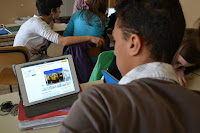Here is a simple strategy that can be used to differentiate instructions,
both in individual learning space - home - and in class.
What you need is a text and Thinglink, a free tool.
Basically, what Thinglink allows you to do is to choose a picture and make
it interactive.
Here is an example of what you can do.

click on the image to be redirected to the activity
I took a picture of a page from a book – which, by the way, is Goodnight
Stories from Rebel Girls 2 –, I uploaded it on Thinglink and just added some
links.
The learning goal for this activity was practising reading comprehension
and writing skills.
In our Esl mixed ability classes we have students at very different
levels and making them work on the same tasks is never the best option.
Starting from the same text, it is possible to meet the students’ different
needs by differentiating both the process and the outcome, the final product.
If you roll over the image some icons will pop up. As you can see
they have different colours and each colour corresponds to a certain degree of
difficulty.
Let’s take the green icons: they are the easiest tasks. Basically it is
comprehension questions but they are placed exactly where the answers can be
found. Moreover, some hints are given to the students, to help them with
grammar or vocabulary.
The blue icons are sort of half-way level and what students
have to do is to answer questions but there’s no scaffolding here.
And finally the orange icons. That is the expert level. Here students are
asked to analyze and reflect on some aspects of the story/biography
and there are also extension activities for them to go deeper into the content.
This interactive image can be used in many different ways, it just depends
on the learning goal, so it could be done as a class activity, or it could be
assigned for homework.
It works as an assessment strategy as well, both formative and summative.
In this last case students know that if they work on survival level the maximum
score they can get is 7 out of ten, if they choose half-way level the maximum
score is 9 or for the expert level the maximum grade is
10.
Last thing, if you click on the speaker icon in the bottom right-hand
corner, you are redirected to the audio version of the biography, read by the
teacher, and this can help auditory learners or dyslexic students.
Here is a video with feedback from the students. They
seem to appreciate this way of working on reading comprehension.
Click here to open the
activity and feel free to use it with our students.








































